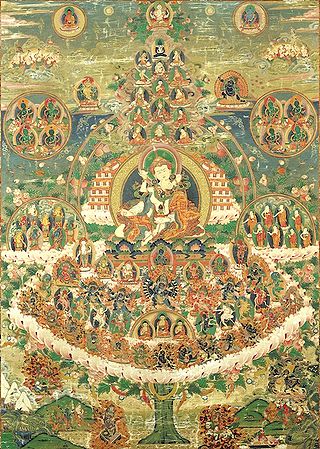Ngöndro

Ngöndro (Tib. སྔོན་འགྲོ་, Wyl. sngon ‘gro) — the preliminary or ‘foundation’ practices of Vajrayana Buddhism. The ngöndro practices are profound and powerful means for effecting a deep purification and transformation, at every level of our being. Not only do they prepare the practitioner for the profound path of Vajrayana and teachings of Dzogchen, but they also lead him or her gradually towards the experience of enlightenment.
Dilgo Khyentse Rinpoche said:
- When we take our first steps on the Path, we are not yet capable of helping others. To accomplish the good of others, we must first perfect ourselves, by purifying and transforming our minds. This is the aim of what we call the preliminary practices, which establish the foundations of all spiritual progress. You may feel like dispensing with these foundations in order to practice teachings that you think are more profound, but if you do so, you are building a palace on the surface of a frozen lake.[1]
Etymology
In Tibetan, ngön means ‘before’, whilst dro means ‘to go’. So ngöndro is usually translated as ‘preliminary practices’, or ‘foundation practices’.
Stages of the Practice
The Outer Preliminaries
The foundation practices begin with a series of life-changing contemplations—the outer preliminaries—embracing:
- the uniqueness and opportunity of human life;
- the ever-presence and deeper meaning of impermanence and death;
- the infallibility of the cause and effect of our actions, karma; and
- the repetitive cycle of frustration and suffering that is samsara.
These contemplations are known as the "four thoughts".
The Inner Preliminaries
These reflections inspire a strong sense of renunciation, an urgent desire to emerge from samsara and follow the path to liberation, which forms the foundation for the specific practices—the inner preliminaries—of:
- taking refuge in the Buddha as the guide, the truth of his teaching (the Dharma) as the path, and the example of his practitioners (the Sangha) as companions on the path, so awakening a confidence and trust in our own inner buddha nature;
- giving birth to love and compassion—bodhichitta, the heart of the enlightened mind—and training the mind to work with ourselves, with others, and with the difficulties of life;
- removing obscurations of all kinds through the purification and healing practice of meditating on Vajrasattva and reciting his mantra;
- accumulating merit and wisdom by developing universal generosity and creating auspicious circumstances, through the mandala offering;
- finally, in the practice of guru yoga, which is the most crucial, moving and powerful practice of all, we unite our mind with the wisdom mind of all the buddhas and so awaken the wisdom of realization.
Purifying the Obscurations
It is sometimes said that
- prostrations remove the obscurations associated with the body,
- recitation of the hundred syllable mantra removes obscurations associated with speech,
- mandala offering removes obscurations associated with mind, and
- guru yoga removes the obscurations of all three: body, speech and mind.
Versions of the Ngöndro
The principal ngöndros that the Rigpa sangha practise are:
- The Excellent Path to Enlightenment
- the Brief Dudjom Tersar Ngöndro, and
- the Longchen Nyingtik Ngöndro.
Notes
- ↑ Dilgo Khyentse, The Excellent Path to Enlightenment, Snow Lion Publications, page 10.
Teachings Given to the Rigpa Sangha
- Khandro Rinpoche, Rigpa London, UK, 21 March 2019